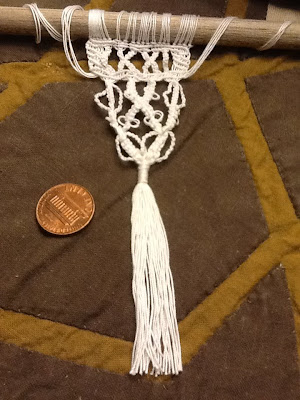The focus of the
challenge is on outerwear, mainly coats of various sorts, but since I already have a stunning loose gown which I rarely get to wear I'm going to be working on a Venetian-style veil.
Poking about for inspirational pictures on the web has shown me that while Venetian veils share a common theme as to size (huge!) there is a great deal of variety in shape, color, texture, opacity, decoration and manner of wearing.
Shape: I see evidence of rectangles, triangles and half-circles being common veil shapes. Additionally I find several illustrations that suggest the veil may be a rectangle which has been folded across the breadth and stitched together along one of the long edges. (Thus making a 1/2 open pouch shape rather like a coif) Admittedly, the pouchy bagginess of the drape of these veils could have been achieved in other ways--such as the judicious use of pins--but I find the possibility of a structured veil intriguing.
Color: Along with black, white, and the legendary yellow, I find evidence beige, blue, gold, red, pink and green. Notably, one example appears to be a two-color shot silk organza whose overall effect is a coral-pink.
Texture: I see evidence of veils in a variety of textures, fine to coarse, plus both smooth and textured weaves. In addition, the veils appear to have a variety of 'hands' from a liquid drape to a rather crunchy stiffness.
Opacity: While I had believed that the veil would be slightly-translucent-to-opaque in most cases, it appears that the reverse may be true. In the majority of illustrations I have seen the veil material is in the translucent-to-sheer end of the range and it is frequently very nearly transparent. It should be noted, however, that once removed from the head an opaque veil simply looks like a shawl, tablecloth, or random piece of fabric drapery so it is likely that I have misinterpreted some objects that a period viewer would have recognized as opaque veils.
Decoration-Overall: In addition to the many examples of various types of woven stripes, I find hints of more elaborate patterns. Whether these patterns were confined to bands at the edges of the veil and whether woven or applied is unclear.
Decoration-Edge: Plain hems, fringe, plain lace, tassels and ornamented lace are all seen.
While there may well have been meaning ascribed to veils of different colors, etc. (the language of the veil :) ), it seems likely that, in some cases at least, the color, shape and materials of one's veil were a personal aesthetic decision.
So, I have been mulling over options for a new veil. I am on a personal mission to bring more pattern into SCA events so I rather like the idea of of a striped veil. I also really like handwork and trying new things so I've been thinking a lot about edge treatments. Hmm. What to do?
Which brings me to the afore-mentioned concurrences...
Veil Option 1:
Sheer with woven textured stripes

Mores Italiae, 1575

Mores Italiae, 1575

Agnolo Bronzino, 1550

Corded silk Organza (available on e-bay)
Veil Option 2:
Sheer with woven gold stripes

Cesare Vecellio 1589-90

Bartolomeo Veneto 1520's

Silk organza with gold stripes (available on ebay)
Veil Option 3:
Translucent with an amazing edging
I'm thinking a sheer linen with lace edging...maybe in knotwork?























